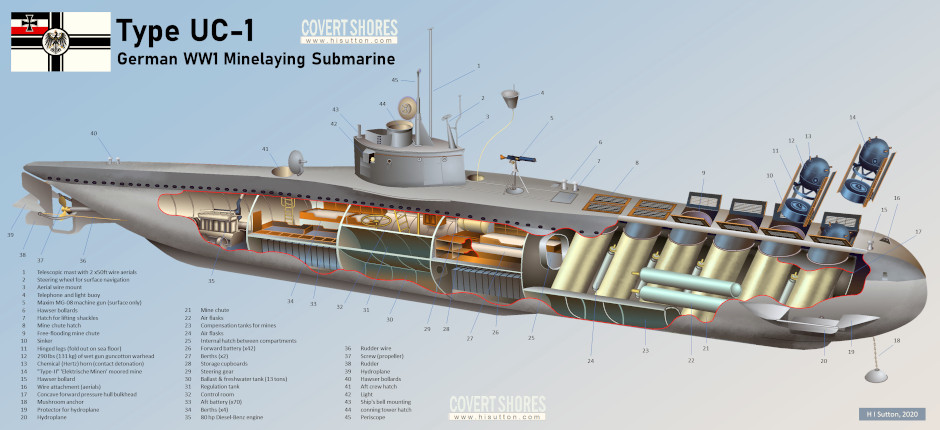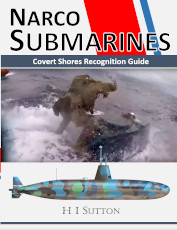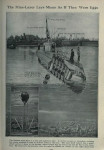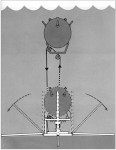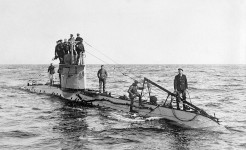German-WW1-Type-UC-1-U-Boat
Forgotten Super-Weapon of WW1: Type UC-1 Uboat
 There are some weapons of World War One are better known than others. It’s natural that some less used, or less successful, types remain obscure. But in the case of mine laying submarines they are largely forgotten despite being one of the most successful weapons of the war. This article will focus on the first German type, the UC-1 Class. It was a very simple, innovative and effective design.
There are some weapons of World War One are better known than others. It’s natural that some less used, or less successful, types remain obscure. But in the case of mine laying submarines they are largely forgotten despite being one of the most successful weapons of the war. This article will focus on the first German type, the UC-1 Class. It was a very simple, innovative and effective design.
Original artwork. CLICK for high-resolution image.
The UC-1 was the first dedicated mine-laying submarine to enter service (nod to the Russian boat Krab), and it took the Allies by surprise. The submarines were not armed with any torpedoes. Instead each boat carried 12 moored mines which were dropped out of the bottom of launch tubes passing through the forward hull. In many respects it was the first vertical launch system.
Get The essential guide to World Submarines
This Covert Shores Recognition Guide Covers over 80 classes of submarines including all types currently in service with World Navies.
Check it out on Amazon
It is a case of a bold new design working first time, the first model, Type UC-1, was incredibly effective. Development was extremely fast. The first boat, UC-1, was ordered in November 1914, launched 6 months later in April 1915 and commissioned in July 1915. And less than a month later it claimed its first victim, HMS Lightning, a Janus class destroyer. This is all even more impressive when you consider that it was less than 15 years after the Imperial German Navy (Kaiserliche Marine) built its first submarine.
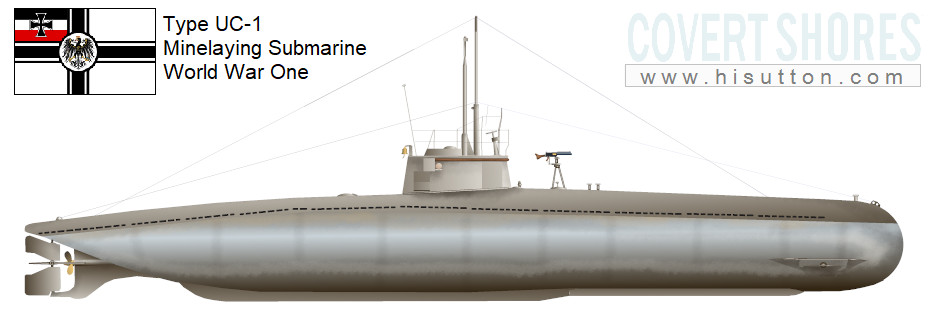
15 Type UC-1 boats were built in rapid succession, together accounting for a vast tonnage of enemy/neutral shipping. 4 of the boats managed over 70 war patrols each. The type was small and cheap and only needed 14 crew. Accommodation was very basic but they only needed to carry out short missions of a few days at a time. They’d sail across the North Sea to the busy shipping lanes off England’s east coast and lay their mines. Their stealth meant that they could lay a mine barrage covertly, often right outside a British port.
UC-1 Specifications
Displacement: 185 tons surfaced, 202 tons submerged
Length: 33.99m (111.5 ft)
Beam: 3.15m (10.3 ft)
Operating depth: less than 50 m (160 ft)
Speed: 6.2 knots surfaced, 5.2 knots submerged
Propulsion: 1 × 6-cylinder diesel engine (66 kW; 89 bhp), 1 × electric motor (129 kW; 173 shp)
Armament: 12 x Type-II electric moored mines, 1 x MG-08 machine gun
Crew: 14
The World’s ONLY Guide to
Narco Submarines
10 years of research, analyzing over 160 incidents, condensed into a handy guide. This unique book systematically breaks down the types and families. With detailed taxonomy, recognition 3-views, profiles and photos. Available on Amazon
The German Kaiserliche Marine’s purpose-built mine laying submarines took a massive toll on shipping during the First World War. Yet the submarines, and their exploits, are largely overlooking in favor of their torpedo-armed brothers. In the words of Iain Ballantyne, author of The Deadly Trade (USA: The Deadly Deep)…
“The record of German mine-laying submarines was rather formidable, with UC-1 alone notching up 41 enemy vessels sent to the bottom via her mines. [Yet] mine-laying submarines are often denied the credit they deserve. I suppose this is because the act of leaving such fiendish parcels of destruction in a foe’s shipping lanes, their territorial waters, or in the approaches to a dockyard or port is just too unglamorous. It cannot compare with the drama of the submarine captain, cap turned around, eyes pressed to the periscope cups as he unleashes a salvo of torpedoes. That is a very direct, instantly violent act. The whole point of laying mines for a mine-laying boat’s CO is to do it without ever giving away the presence of his boat, for them to then lie in wait and claim unsuspecting victims in the weeks, months or years to come.”
####
The Type UC-I was quickly succeeded by the improved Type UC-II class. This was about twice the size and carried 18 mines. It also had a torpedoes. because of the forward placement of the mine chutes, per UC-I, the forward torpedo tubes had to be external. Two 50cm (19.5”) torpedo tubes were mounted alongside the forward casing. The aft section was fitted with an internal torpedo room with up to 7 torpedoes, launched via a single tube in the stern. in lessons learned from earlier boats the UC-IIs had a more typical boat-shaped bow to improve surface running. of these boats were built, starting in 1916. The UC-II are considered the most successful submarine design in history accounting for more than 1,800 ships.
The ultimate book of Special Forces subs Covert Shores 2nd Edition is the ONLY world history of naval Special Forces, their missions and their specialist vehicles. SEALs, SBS, COMSUBIN, Sh-13, Spetsnaz, Kampfschwimmers, Commando Hubert, 4RR and many more.
Check it out on Amazon
Related articles (Full index of popular Covert Shores articles)





 Nordenfelt steam powered submarines of the 1880s. w/Cutaway
Nordenfelt steam powered submarines of the 1880s. w/Cutaway


 Type-212 AIP submarine w/Cutaway
Type-212 AIP submarine w/Cutaway

 Surcouf Cruiser Submarine w/Cutaway
Surcouf Cruiser Submarine w/Cutaway

 Type-XXIXH stealth U-Boat. w/Cutaway
Type-XXIXH stealth U-Boat. w/Cutaway


 Yugoslav X-Craft (R-3E / 911 Class)
Yugoslav X-Craft (R-3E / 911 Class)

 Japanese Ko-Hyoteki midget submarine of WW2 - Pearl Harbor attack
Japanese Ko-Hyoteki midget submarine of WW2 - Pearl Harbor attack

 Japanese Ha201 Sen-Taka-Sho fast attack submarine of WW2
Japanese Ha201 Sen-Taka-Sho fast attack submarine of WW2

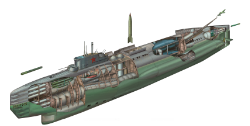 Stalin’s Super Sub, Project P-2. w/Cutaway
Stalin’s Super Sub, Project P-2. w/Cutaway

 WW2 German Delfin midget submarine with AIP
WW2 German Delfin midget submarine with AIP

 Narwal / Orca Dry Combat Submersible (UWTG)
Narwal / Orca Dry Combat Submersible (UWTG)

 Project 09852 Belgorod Special Mission submarine (spy sub). w/Cutaway
Project 09852 Belgorod Special Mission submarine (spy sub). w/Cutaway

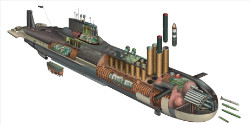 TYPHOON Class SSBN. w/Cutaway
TYPHOON Class SSBN. w/Cutaway

 A-26 Blekinge Class attack submarine. w/Cutaway
A-26 Blekinge Class attack submarine. w/Cutaway


